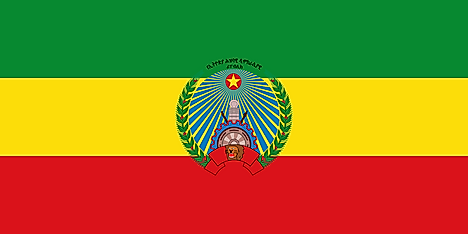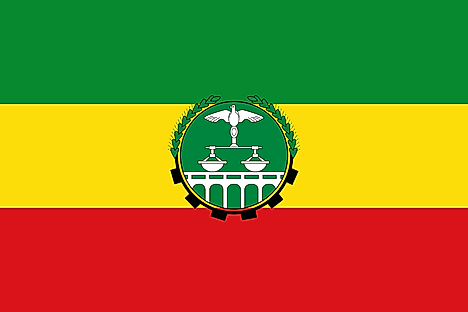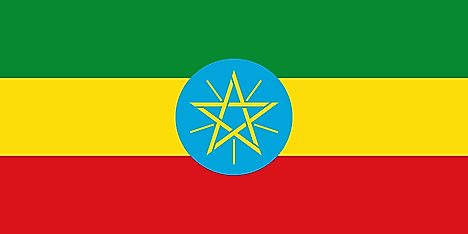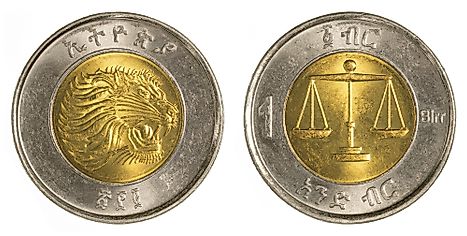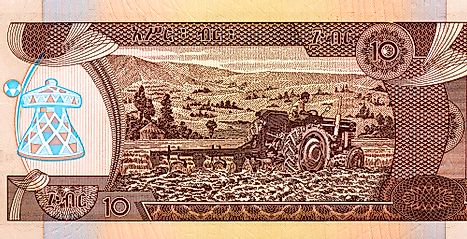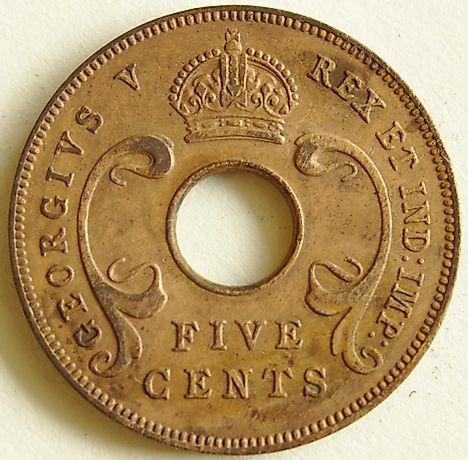Flags, Symbols & Currency of Ethiopia
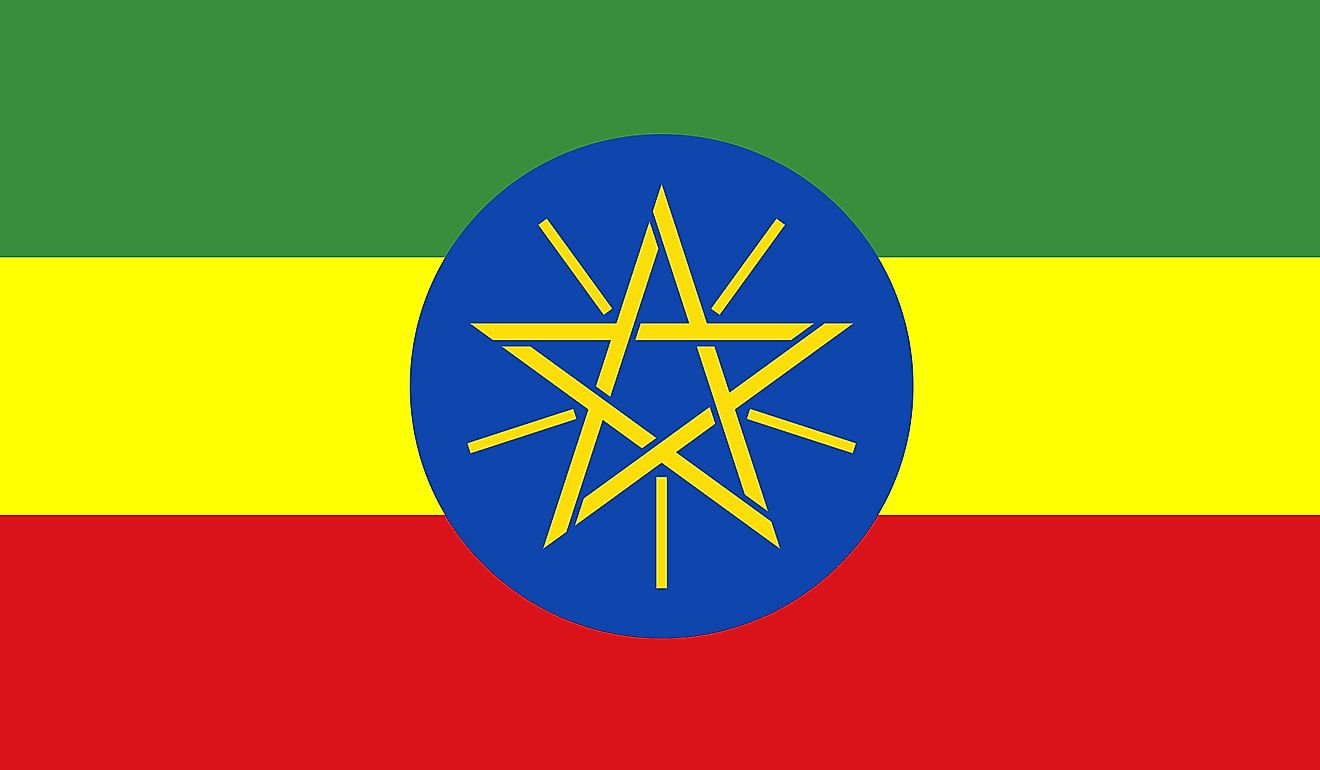
The National Flag of Ethiopia was officially adopted on October 31, 1996. The flag has been designed by Abebe Alambo.
The National Flag of Ethiopia features three equal horizontal bands of the Pan-African colors: green (top), yellow, and red. On a light blue disk centered on the three bands is a yellow pentagram with single yellow rays emanating from the angles between the points. The green color represents hope and the fertility of the land. The yellow color symbolizes justice and harmony. The red color symbolizes strength and stands for sacrifice and heroism in the defense of the land. The blue disk symbolizes peace and the pentagram represents the unity and equality of the different nationalities and the people of Ethiopia. The flag has a width-to-length proportion ratio of 1:2.
History of the Flag of Ethiopia
During the 16th century, the flag of the Aussa Sultanate was the first flag that was flown in Ethiopia. During the 17th century, the red, yellow, and green pennants were flown. The first official flag in 1897 featured a horizontal tricolor of green-yellow-red along with the Lion of Judah at the center of the flag. In 1974, this flag was slightly modified after the defeat of the Ethiopian Emperor Haile Selassie I. The crown and Staff which the Lion of Judah carried was replaced with a spear. Between 1974-1987, when Ethiopia was under the Derg rule, the lion was removed from the flag. After 1987, with the formation of the Socialist People’s Democratic Republic of Ethiopia, the socialist emblem now featured at the center of the flag. In 1991 when the People’s Revolutionary Democratic Front gained power, the socialist emblem was removed. In 1996, the Ethiopian emblem was added and placed in the center of the flag.
Symbols of Ethiopia
The National Coat of Arms of Ethiopia

The current official National Coat of Arms of Ethiopia was adopted in 1996. It is composed of a golden pentagram with radiating rays of light within a blue circle. The blue circle symbolizes peace and the pentagram represents the unity and equality of the different nationalities and the people of Ethiopia.
National Anthem
- Anthem Title: "March Forward, Dear Mother Ethiopia"
- Music Composer: Solomon Lulu Mitiku
- Lyricist: Dereje Melaku Mengesha
- Date of Adoption: 1992
"March Forward, Dear Mother Ethiopia" is the national anthem of Ethiopia. The music of the anthem have been composed by Solomon Lulu Mitiku. The lyrics of the anthem have been authored by Dereje Melaku Mengesha. The anthem was officially adopted in 1992.
ወደፊት ገስግሺ ውድ እናት ኢትዮጵያ (Amharic)
የዜግነት ፡ ክብር ፡ በኢትዮጵያችን ፡ ጸንቶ ፣
ታየ ፡ ሕዝባዊነት ፡ ዳር ፡ እስከዳር ፡ በርቶ ።
ለሰላም ፡ ለፍትሕ ፡ ለሕዝቦች ፡ ነጻነት ፣
በእኩልነት ፡ በፍቅር ፡ ቆመናል ፡ ባንድነት ።
መሠረተ ፡ ጽኑ ፡ ሰብእናን ፡ ያልሻርን ፣
ሕዝቦች ፡ ነን ፡ ለሥራ ፡ በሥራ ፡ የኖርን ።
ድንቅ ፡ የባህል ፡ መድረክ ፡ ያኩሪ ፡ ቅርስ ፡ ባለቤት ፣
የተፈጥሮ ፡ ጸጋ ፡ የጀግና ፡ ሕዝብ ፡ እናት ።
እንጠብቅሻለን ፡ አለብን ፡ አደራ ፣
ኢትዮጵያችን ፡ ኑሪ ፡ እኛም ፡ ባንቺ ፡ እንኩራ ።
"March Forward, Dear Mother Ethiopia"
Respect for citizenship is strong in our Ethiopia;
National pride is seen, shining from one side to another.
For peace, for justice, for the freedom of peoples,
In equality and in love we stand united.
Firm of foundation, we do not dismiss humanness;
We are people who live through work.
Wonderful is the stage of tradition, owners of a proud heritage,
Natural grace, mother of a valorous people.
We shall protect you – we have a duty;
Our Ethiopia, live! And let us be proud of you!
The Currency of Ethiopia is the Ethiopian birr
The current official currency of Ethiopia is the Ethiopian birr (ETB). The Ethiopian birr is subdivided into 100 santims.
Coins
The first Ethiopian birr coins were in circulation between 1894 and 1897. The coin denominations included the copper coins of 1/100 and 1/32 birr, silver coins of 1 ghersh, 1⁄8, 1⁄4, 1⁄2, and 1 birr, and the gold coins of 1⁄4, 1⁄2, and 1 werk. There was a new system of coins that began in 1931.
The second Ethiopian birr coins were introduced in 1944 and consisted of copper coins of 1, 5, 10, and 25 santim and the silver coins of 50 santims. In 1977, a new series of coins was introduced.
Currently, coins in denominations of 1, 5, 10, 25, 50 santims, and 1 birr are in circulation.
Banknotes
The Bank of Abyssinia introduced the first set of notes in 1915. It consisted of 5,10,100 and 500 talari. In 1932, the Bank of Ethiopia gave out the same denominations of notes. In 1945, the State Bank of Ethiopia introduced the second series of the notes in denominations of 1, 5, 10, 50, 100, and 500 birr. From 1966, the production of banknotes was in all the denominations except the 500 birr with the National Bank of Ethiopia being the producer.
Currently, Banknotes in denominations of 1, 5, 10, 50, 100, 200 birr are in circulation.
Historical Currencies of Ethiopia
Salt blocks called “amole tchew” and Maria Theresa thalers were the currencies used in the 18th and 19th centuries. The combination of the names birr, Thaler, and dollar was the name talari which on February 9, 1893, it became the standard unit made up of 20 ghersh. In 1903, a new series of coins came into circulation in the forms of silver ghersh and quarter-birr. The weight of silver ghersh was 1/16 of that of birr. The Bank of Abyssinia was importing approximately 1,200,000 Marial Theresa thalers by the start of the First World War, and in 1915, the bank brought banknotes into circulation. The Italian lira came into service during the period 1936-1941. On July 15, 1936, there was the introduction of the Italian lira following the transformation of Ethiopia after the Italians occupied the country. Also, the circulation of the Ethiopian banknotes was withdrawn to increase the flow of Italian money. During the period 1941-1945, the East African shilling was used after the East African Campaign of 1941 that lead to the introduction of the currency by the British forces. In 1945, there was the introduction of the second birr with the conversion rate of 2 shillings per birr. The circulation of the Ethiopian currency consisted of the Menelik talari and Maria Theresa by the mid of the 1930s. The currency of Ethiopia before 1931 was referred to as the Abyssinia birr, and after 1931 up to date, the currency’s name is Ethiopian birr.
